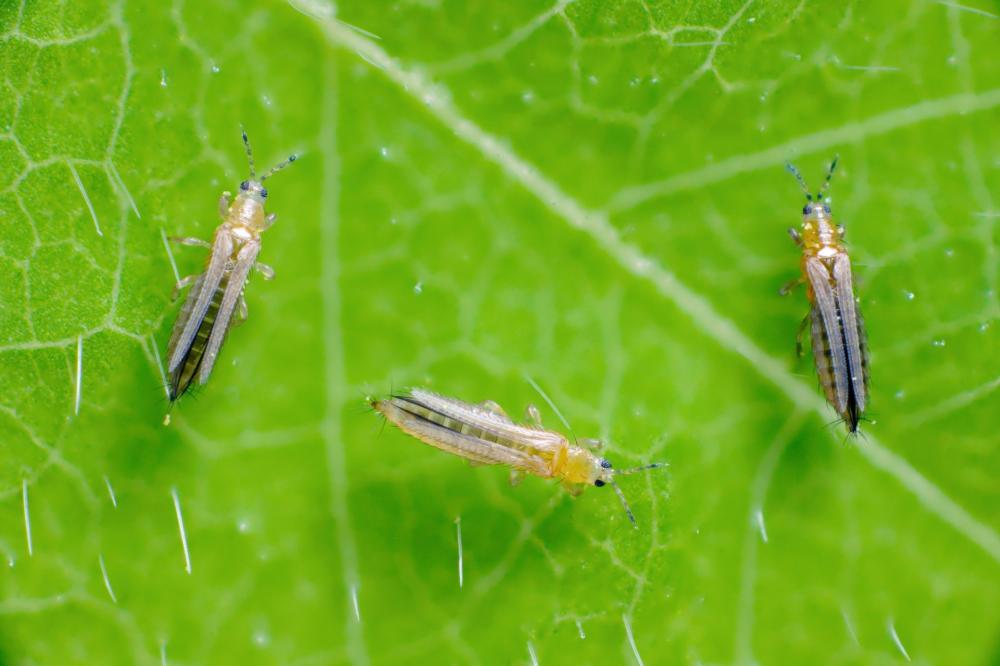
- Thrips are one of the most dangerous insect pests affecting agricultural crops, especially in greenhouses and exposed vegetable gardens. This insect is very small (no more than 2 mm in length), but it has a tremendous capacity to reproduce and spread. It feeds by sucking plant sap from leaves and flowers, causing silvery spots and curling of leaves and deformed fruit.
- Thrips are dangerous not only because of the direct damage they cause, but also because they are a major vector for a number of plant viruses, such as the spotted wilt virus (TSWV) , which causes significant losses in sensitive crops. Given their rapid reproduction and the potential for multiple generations to appear in a single season, thrips control becomes a real challenge that requires integrated management.
Symptoms of infection
- 🌱 Silver spots or pale lines on leaves due to sap absorption.
- 🍂Wrinkling of leaves and dryness of their edges.
- 🌸 Flower deformity and weak fruit setting.
- 🍓 Deformed or underdeveloped fruits such as tomatoes and strawberries.
- 🦠 Transmission of plant viruses that cause crop wilting and reduced production.
- 🌾 The most affected crops
- 🍅 Tomatoes: The crop most susceptible to thrips.
- 🌶️ Pepper: causes flower drop and poor growth.
- 🧅 Onions and garlic: Silver spots and distortion on the leaves reduce the size of the bulb.
- 🥒 Cucumber and zucchini: poor growth and few fruit sets.
- 🍓 Strawberry: Distortion of leaves and fruits.
- 🌻 Flower crops and roses: Loss of marketing value due to flower deformity.
Thrips life cycle
- Eggs: Laid inside leaf or flower tissue and are difficult to see.
- Nymphs: hatch after 3–5 days, feed directly on plant sap and begin to cause damage.
- Pupae: Nymphs move to the soil or protected areas to pupate, during which they do not feed.
- Adult insect: Appears after about two weeks, less than 2 mm long, and begins to reproduce rapidly.
- 🔄 The complete thrips cycle takes about 15–20 days in the summer , causing them to produce repeated generations in a single season and making them more difficult to control.
economic damage
- Reduced vegetative growth and poor crop production.
- Fruit deformity and difficulty in marketing.
- Huge losses when viruses are transmitted.
- High costs of repeated pest control and difficulty of complete eradication.
Prevention methods
- 🌿 Remove surrounding weeds as they are a major shelter for thrips.
- 🪟 Installing tight mesh on greenhouses to prevent insects from entering.
- 🌸 Plant less sensitive varieties when available.
- 💧 Commitment to balanced irrigation and fertilization to maintain plant strength.
- 🪰 Use blue sticky traps to monitor infestation early and reduce insect numbers.
Active ingredients to combat thrips
- Spinosad: 0.3–0.5 ml per 1 liter of water – repeated every 10–14 days.
- Abamectin: 0.5–1 ml per 1 liter of water – repeated every 7–10 days.
- Imidacloprid: 0.25–0.5 ml per 1 liter of water – repeated every 14 days.
- Emamectin benzoate: 0.25–0.5 g per 1 liter of water – repeat every 10–14 days.
- Lambda-cyhalothrin: 0.5–1 ml per 1 liter of water – repeat every 14 days.
Practical tips for farmers
- Thrips are very small and difficult to see, so the leaves should be checked regularly, especially the underside.
- Control should be started immediately upon the appearance of the first symptoms and not wait.
- It is preferable to alternate between active ingredients to avoid the development of resistance.
- Combining chemical control with agricultural prevention gives the best results.

